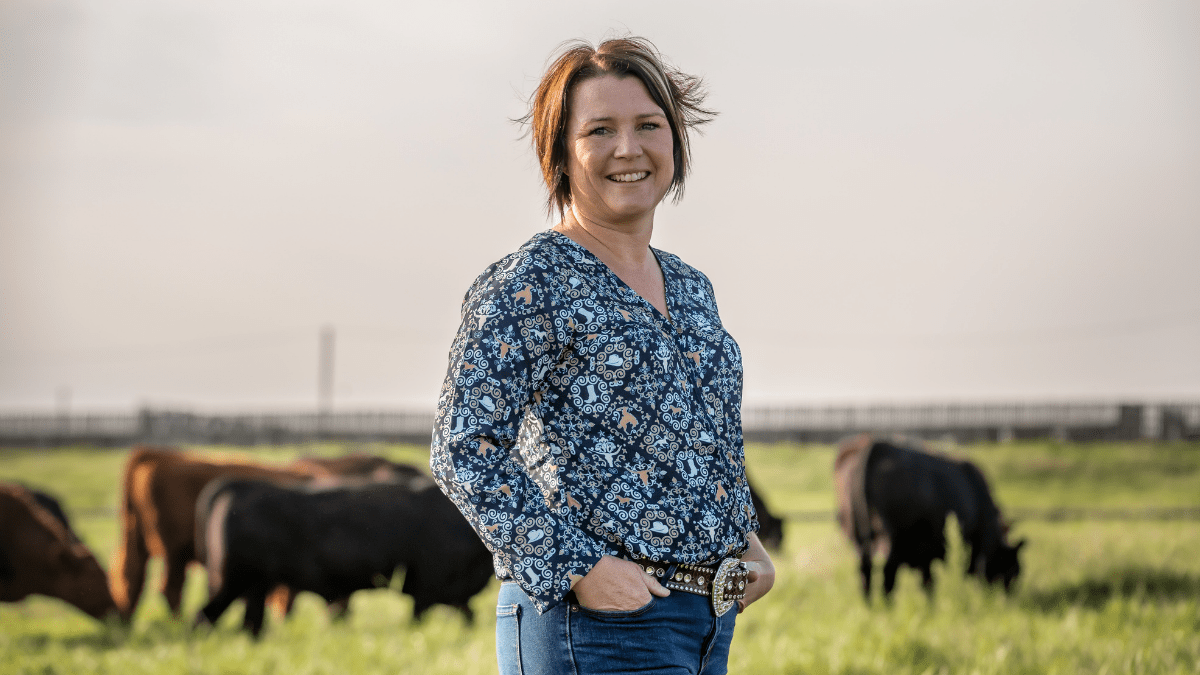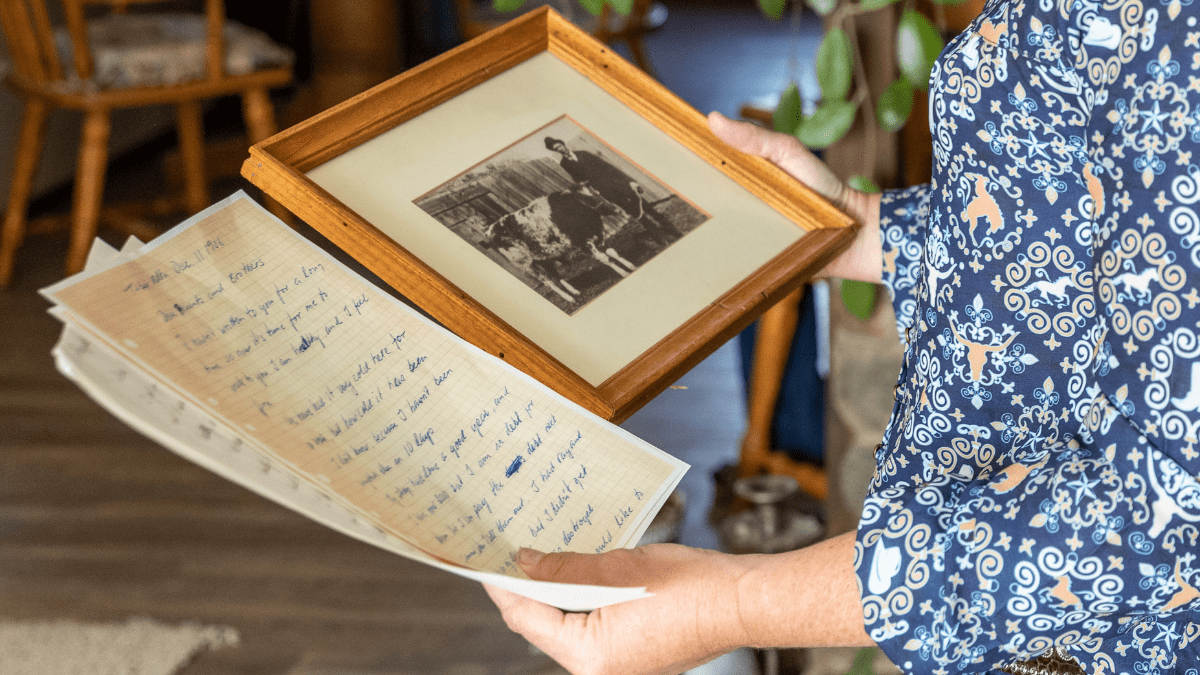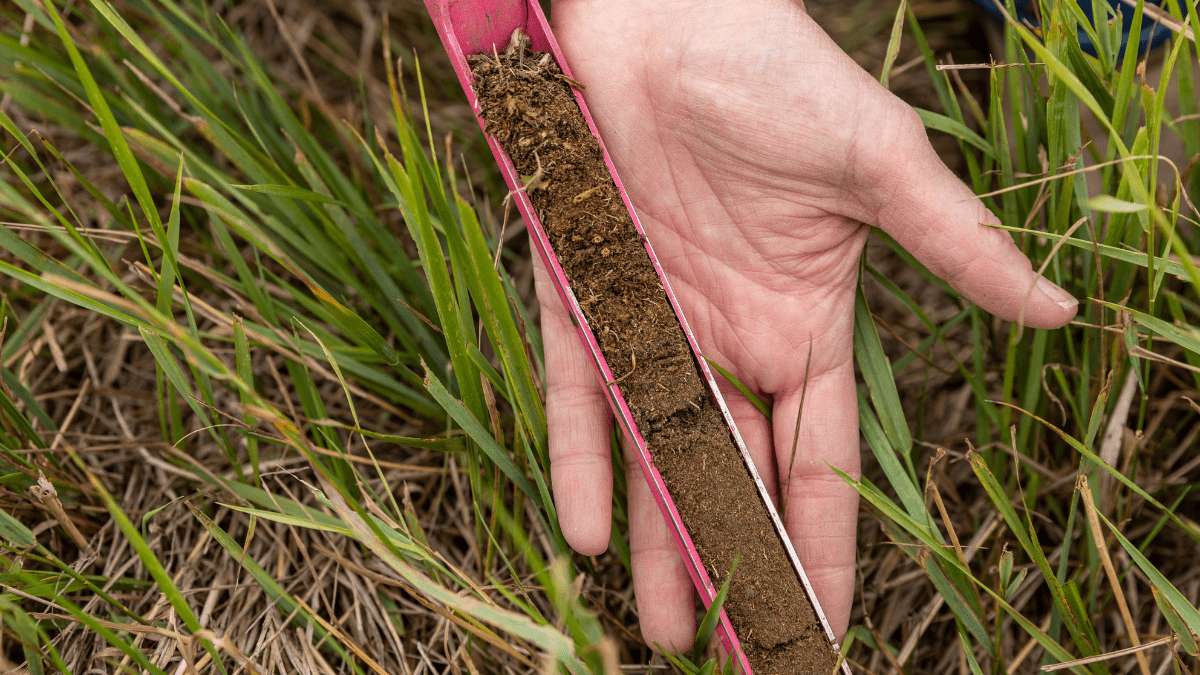Keeping beef cattle on the move and carbon in the soil
Audentes Fortuna Iuvat: This Latin proverb translates as “Fortune favors the bold,” in reference to the ancient Roman goddess, Fortuna. This phrase has adorned coats of arms and emblems for families, teams and societies throughout world history, advocating the virtues of bravery and the prosperous rewards that can come from it.
While this proverb may not be the official motto of Andrea Stroeve-Sawa and her family business, Shipwheel Cattle Feeders Ltd., the story behind this agricultural enterprise — from its humble yet extraordinary beginnings to its current innovative successes — embodies the same message.
“My Great-Grandpa (Albert) Green started farming in 1893, and he was 17 years old,” Andrea said, explaining the origins of her family’s business in Taber, Alberta, Canada, about two hours from the U.S. border. “The eldest of three sons, he grew up in a time in Sweden of massive drought, poverty and famine, and the story goes that, one night, he overheard his parents talking about the famine and poverty and how they were going to have to send somebody out to work, because they couldn't afford to feed all the mouths that they had to feed.
“So, in the middle of the night, Albert just took it upon himself to go down to the boat docks and board a ship, and he landed in America in search of a better life, in search of starting his own farm and in search of a different life and to send money home to his family,” Andrea continued. “And so, he arrived in Michigan and then worked his way up to Skiff, Alberta.”
Nearly 130 years later, Albert Green’s courage and bravery continue to reap rewards. Shipwheel covers about 900 acres of grassland and comprises a yearling grazing program, a 5,500-head cattle feedlot, bee pollinators, pasture-raised chickens, a no-till “chaos” garden, a fruit orchard and agricultural compost production. Andrea is the fourth generation of her family to manage the operation, but in the same spirit as Great-Grandpa Green, she still searches the horizon for unforeseen opportunities.
Shipwheel defines a “chaos” garden as the following: “The basic idea behind a chaos garden: Mix the seeds in a bag, scatter in loose soil and then sit back and see what happens. As long as you start with soil that’s somewhat loose and bare on the surface, some will sprout and take root. We choose to use cattle to ‘disturb’ the land instead of some means of mechanical tillage because with mechanical tillage we would definitely destroy the habitat of the millions of microbes that take residence in the topsoil.”
“I feel an immense responsibility for the way that I not only maintain what we currently have, but now, I feel like I have to push past where we are and do more,” Andrea said. “Do better. Be bigger.”

Paddocks lead to productivity boost
When Andrea says she feels the need to “do better,” she is not just talking about economics. Sustainability and caring for the land are important aspects of Shipwheel’s modus operandi, and she credits her father, Blake, with implementing this ethos.
In the early 1980s, Blake — with baby Andrea in tow — attended a conference on holistic farm management held by Zimbabwean ecologist Allan Savory. The sparsely attended talk touched on topics that were considered radical at the time but struck a chord with Blake.
“Everything that he was saying made completely logical sense in Dad's brain, and it was different than anything he'd ever done in agriculture thus far,” Andrea said. “But it was logical: working with the ecosystem, allowing the plant to rest and photosynthesize — and, I mean, we didn't know as much then as we do now about what happens underneath the ground as far as microbes and storing carbon and mycorrhizal fungi and the functional glomalin and all those things, but we knew about photosynthesis, and we knew about ecosystems and the water cycle and mineral cycle, and all those things made sense.”
Blake went straight to work on converting their long-established continual grazing operation into 65 different paddocks and three separate grazing cells. While this move may have been seen as peculiar, or even ridiculous, by their peers, for the descendants of Albert Green, decisions like this were what drove the success of the family business.
After adopting holistic land management practices — or what Andrea personally refers to as “adaptive multi-paddock grazing” — the benefits were soon obvious. Improvements in the physical look of the land, the water cycle and the mineral cycle told the family that they were becoming more productive and definitely better than average. These changes also brought more wildlife and forage to the land. But it was not until many years later, when Andrea took her place at the helm of the operation, that the family saw the proof of just how much these radical changes had boosted their business.
Digging out and poring over faded, yellowed grazing charts and pictures dating back to 1982, Andrea traced the farm’s stocking days, revealing that they had gone from an initial 2.36 stock days per acre to reaching around 110 stock days per acre this year. From where they started, this is an increase in productivity of a staggering 3,862%.

“I had to do the math four times to convince myself,” Andrea admitted. “When I looked back to the Ecological Suggested Stocking Rate, which was for our soil type in our area, I realized that we were stocking cattle at six times the suggested stocking rate.”
Of course, there are bigger-picture benefits to multi-paddock grazing. Moving the cattle between paddocks allows the natural vegetation to flourish and, most importantly, to photosynthesize. Plants use energy from sunlight to build carbohydrates from CO2 and water. Most of the carbohydrates plants produce go into growth, but they also release exudates into the soil, which helps build up soil carbon and creates a healthy soil microbiome.
Even with cattle feeding on any given day, Andrea says that 30% of the vegetation is able to photosynthesize. Overall, this means that, along with significantly increasing production, Shipwheel has also managed to integrate natural carbon sequestration methods into the operation, reducing greenhouse gas emissions.
From feedlot waste to fertilizer: Creating nutrient-rich compost
Another environmentally friendly procedure established by Blake was the upcycling of Shipwheel’s feedlot waste into nutrient-rich compost. This idea again came from a class he attended, after which Blake immediately integrated a process for utilizing the 20,000 metric tons of organic matter — namely, manure and bedding — from the feedlot.
According to Andrea, through this process, the operation produces an average of somewhere between 10,000 to 15,000 metric tons of compost. Half of this is used on Shipwheel land as an organic fertilizer, while the other half is sold to local farmers, who are more than happy to use it on their own land.
“We see the compost as a tool to (impact) many acres of land,” Andrea said. “Over the last few years, we have seen that the demand for compost has increased to the point that we can’t meet demand with our current supply.”
With the popularity of their compost products, the Shipwheel team has not only found another way of successfully gaining profits through sustainability, but it has also managed to demonstrate the advantages of using sustainable practices to their peers. In four generations, the business has gone from one person taking a determined shot at building a better life to an enterprise that is now showing others how bold moves can create positive change.
Looking at what Shipwheel has grown into and where they could go from here, Andrea is confident that her Great-Grandpa Green would look fondly on his legacy.
“He had the dream that he was going to be a farmer, but he didn't necessarily know how successful he was going to be,” Andrea surmised. “He didn't know that the fourth generation was even going to be here, right?

“And I don't know what the eighth generation is going to look like,” she continued, “but I think he'd be immensely proud of what he started.”
The Shipwheel blueprint
The name Shipwheel Cattle Feeders only hints at the scope of the entire operation. Over four generations, the farm has implemented and developed a whole host of innovative projects. Taking an all-encompassing look at Shipwheel, the blueprint incorporates:
- Multi-paddock adaptive yearling grazing
- A 5,500-head cattle feedlot
- Beekeeping
- Pasture-raised chickens
- A no-till "chaos” garden
- A fruit orchard
- Manure compost production
- Vermicompost
What sets Shipwheel apart is their unwavering dedication to their holistic management goal of continually improving their land base, the animals entrusted to their care and the community. Let us take a deeper dive into some of the innovative activities on the farm.
1. Low-stress handling (especially during the receiving period)
In 2014, Shipwheel was approached by a customer who wanted to feed cattle without added hormones or antibiotics. They jumped on the opportunity, looking to the knowledge, skill and cattle handling principles taught by rancher Bud Williams. Named one of the “Top Ten Innovations” in the beef industry by Beef Producer in 2011, Bud’s revolutionary stockmanship, combined with high-quality feed and focusing on individual animal care, aligned with the customer’s needs.
This philosophy highlights the importance of focusing on the animals’ emotional well-being, outlining a direct correlation between it and performance. Shipwheel took the knowledge of cattle handling that Bud taught and used it to help boost depressed immune systems and maintain healthy cattle.
“Cattle are herd animals,” explained Andrea. “They far prefer to move as a herd. Our job as caregivers or handlers of the cattle is to gain the trust of the herd through our posture, position, distance and angles while handling. When the cattle have confidence in us as their caregivers, we are then actually able to take the herd for a walk.
“Proper exercise for the herd releases their stress, which will decrease (their) cortisol response, thus increasing the suppressed immune system and breaking the negative cycle of stress,” she continued. “Just as humans would reduce stress through movement individually — by going for a walk, for example — cattle can release stress with proper exercise, but (they) need to do this as a herd as opposed to individually.”
In 2017–2018, Shipwheel fed more than 3,500 ranch-direct cattle. The average weight of the heifers and steers was 451 pounds and 508 pounds, respectively. They were not treated with antibiotics on arrival, were not fed ionophores and did not receive implants. Only 4.74% of the heifers and 6.06% of the steers were treated with antibiotics by the time they weighed 850 pounds.
Every member of the Shipwheel crew must understand Bud's cattle handling concepts and continually practice and apply them. The other leading figure in stockmanship research is Colorado State University professor Temple Grandin. While Bud and Temple differ on their approach and application, ultimately, both have the same goal of working with cattle’s natural tendencies to minimize stress and improve animal welfare through handling. Temple’s research work has changed how we handle cattle across North America and has provided the science to back up what Bud found in the pen — low-stress handling just makes good sense.
Further reading and resources:
- Emotional Fitness in Newly Received Cattle (Drovers)
- Bud Williams Stockmanship and Livestock Marketing (stockmanship.com)
- Review: Reducing Handling Stress Improves Both Productivity and Welfare (grandin.com)
2. Composting
Fifteen years ago, Andrea’s father took a composting class. He came home and started to compost the 20,000 metric tons of manure and bedding from the feedlot to produce an upcycled feedlot waste product.
Shipwheel operates a wind-row composting system in which a mixture of raw materials is placed in long, narrow piles or wind-rows. The team observes and monitors the temperatures of the rows, and when they get to 150–160 degrees Fahrenheit, they turn them with a compost turner. This process helps to aerate the composting materials. The end product is a natural fertilizer high in nitrogen, phosphorous, potassium, calcium and sulfur. Compost helps increase the biological health of the soil, and it also helps decrease the need for synthetic fertilizer. In one teaspoon of compost, there are 1 billion microbes (e.g., bacteria, actinomycetes, fungi, protozoa and nematodes), which are invaluable for boosting soil and plant health.

In Taber, Alberta, Canada, Shipwheel is surrounded by high-value irrigated land used to grow crops such as corn, onions, potatoes, pumpkins and canola. Because of their proximity to this land, they can sell a high-value byproduct to the farmers.
“Every year, in the spring, we clean our pens and put the manure, bedding and whatever other green material we can get our hands on into wind-rows on our (National Resource Conservation Board)-approved compost pad,” Andrea explained. “On average, we haul out about 10,000 wet metric tons that will turn into approximately 5,000 dry metric tons for us to sell.
“We will also sell small amounts of compost to members of our community as a community outreach project,” continued Andrea. “We like the thought of two neighbors comparing gardens (and) saying, ‘Oh, that Shipwheel compost made some great big tomatoes.’ It gives them good feelings about Shipwheel in their community and about regenerative agriculture.”
Shipwheel also boasts a vermicomposting operation. This system of compost bins houses roughly 16,000 red wiggler and European night crawler worms that break down everyday household waste into vermicompost. This mineral-rich soil additive is full of beneficial microbes. Shipwheel sells their vermicompost product, as well as worms for others to make their own.
Further reading and resources:
3. Carbon sequestration
Andrea is passionate about increasing the storage of carbon in the soil, and Shipwheel has been involved in a study of technology that measures exactly that. This project has seen Andrea work with soil microbiologist Dr. Kris Nichols, a leader in the movement to regenerate soils for healthy soil, crops, food, people and the planet. Andrea has also collaborated with Kim Cornish, director of the Food Water Wellness Foundation, an organization that works with farmers, ranchers and researchers to understand how soil can be used to mitigate climate change, droughts and flooding, increase biodiversity and, most importantly, produce healthy food.

“I am very grateful to Dr. Kris Nichols and Kim Cornish,” she said. “These two outstanding women leaders have helped me learn about soil health, mycorrhizal fungi, glomalin and their role in storing carbon and building soil aggregates.”
The Shipwheel team hopes that by working with organizations developing a carbon measurement system, they can put a value on the carbon that they have been sequestering. By maintaining the grassland, keeping the carbon in the soil and putting a value on that carbon, Shipwheel will potentially be able to increase their income per acre in order to compare with high-value cultivated crops, such as potatoes.
Early indications from their participation in the study show that Shipwheel has stored an estimated minimum of 230 metric tons of CO2 equivalent per hectare and as high as 800 metric tons of CO2 equivalent per hectare.
The current Canadian federal government has committed to reducing greenhouse gas (GHG) emissions to 30% below the 2005 levels by 2030.
“What if the cattle feeders, the beef producers and the agriculture industry were the solution to that?” asked Andrea.
Shipwheel is a one-of-a-kind farming enterprise, but the principles they follow are being used throughout the world. Check out the links below to learn more about regenerative agriculture, multi-paddock adaptive grazing and stories of others using these methods to create a better future for our planet.
Further reading and resources: